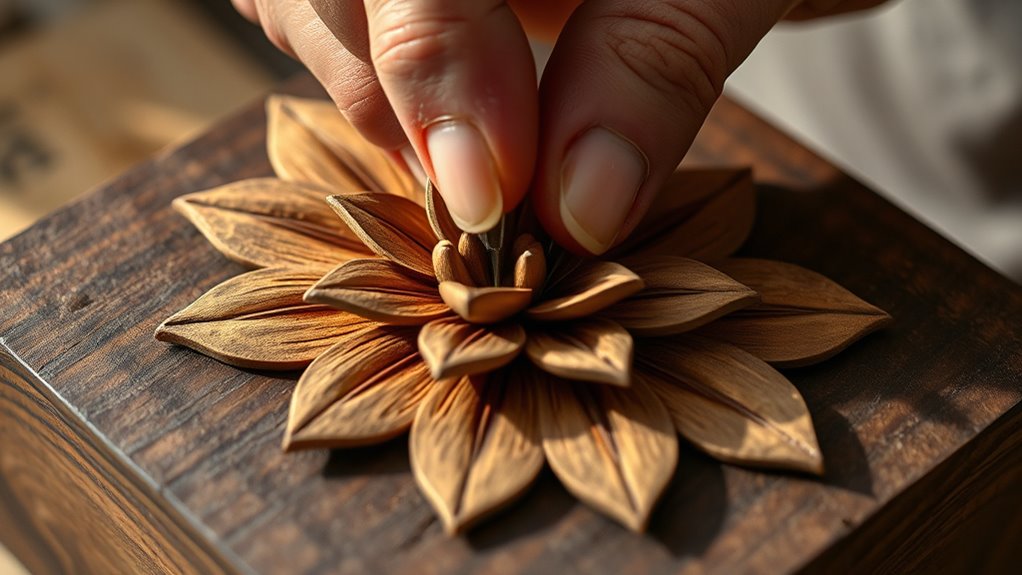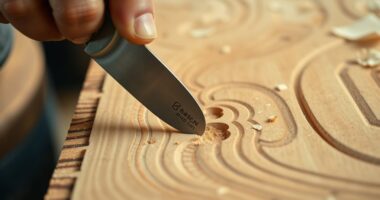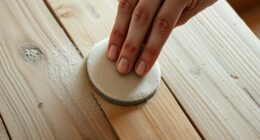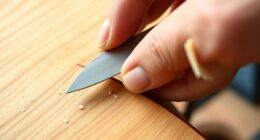To carve realistic flower petals with gouges alone, start by observing natural flowers closely to understand how petals fold and overlap. Use shallow V-shaped gouges for fine veins and U-shaped gouges to create depth and contours. Carve gently with light, consistent strokes, building layers gradually for realism. Focus on controlling pressure and tool angles to mimic natural curves. With patience and practice, you’ll master lifelike petals—keep going to discover more detailed techniques.
Key Takeaways
- Use shallow, controlled cuts with a shallow V-gouge to mimic delicate petal veins and edges.
- Vary cut depths and angles to create natural overlaps and petal folds for realistic layering.
- Carve thin, curved lines following petal contours to replicate veining and surface detail.
- Observe light and shadow to guide carving depth, enhancing three-dimensional realism.
- Practice precise tool control, employing light strokes to refine edges and subtle petal textures.
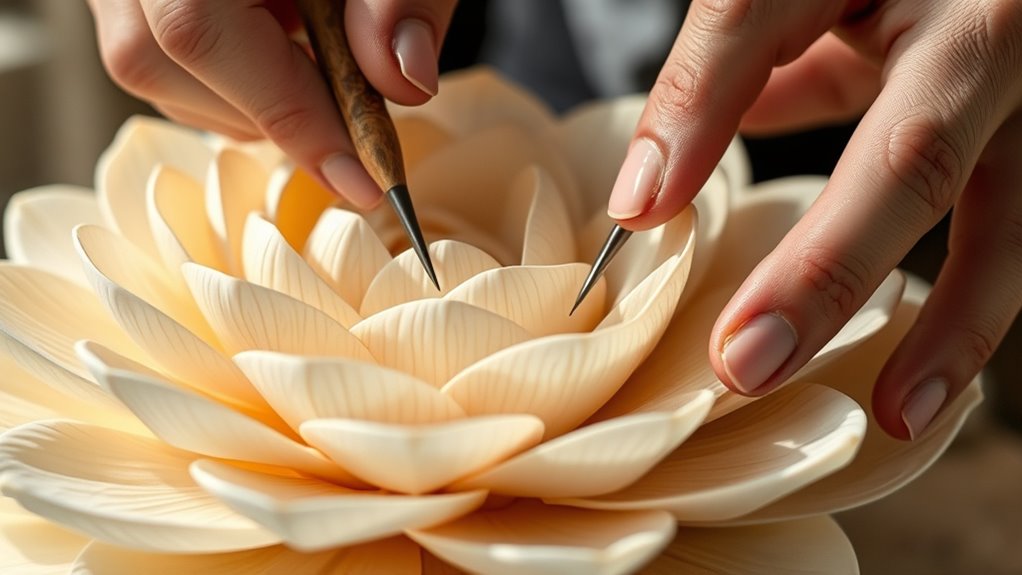
Have you ever wondered how artists create such lifelike flower petals in their carvings? The secret lies in mastering specific techniques and understanding the history of carving. The techniques overview involves a careful combination of tool control, shading, and attention to detail. Historically, carving has been a revered craft dating back centuries, with artisans honing their skills to produce intricate and realistic floral designs. By studying the evolution of carving, you can appreciate how traditional methods and modern innovations come together to produce stunning results.
Mastering carving techniques and exploring its rich history brings floral realism to life in wood.
When you start carving, it’s essential to grasp the foundational techniques that allow you to replicate the delicate nature of flower petals. First, you need to choose the right gouges—these are your primary tools for shaping and detailing. A variety of gouges, from shallow V-shaped to deeper U-shaped, will help you create the natural curves and veins of petals. The technique overview includes carving with precision, often using shallow cuts to build up layers and depth gradually. You’ll want to focus on controlling the pressure to avoid splitting or damaging the wood. Light, consistent strokes are key to achieving a smooth, realistic appearance.
Understanding the history of carving gives you insight into how master artisans achieved such realism with limited tools. Traditional methods relied heavily on hand skills, with carvers passing down techniques through generations. Early carvings often featured stylized flower forms, but as techniques advanced, artists began capturing more intricate details—such as subtle petal folds and fine veins—using simple gouges. This history highlights that realism in carving stems from patience, keen observation, and meticulous execution. By studying old carvings and understanding how artisans approached their work, you can incorporate those timeless principles into your own practice.
To carve realistic flower petals with gouges alone, you must develop a keen eye for detail and an understanding of how light and shadow play across a petal’s surface. Use your gouges to carve thin, curved lines that mimic the natural veins, and vary the depth of your cuts to suggest the gentle folds and overlaps. Pay close attention to the way petals curl and taper at the edges, and replicate those subtleties with your tools. The combination of a solid techniques overview and knowledge of carving’s rich history will inspire you to refine your skills and bring lifelike realism to your floral carvings. With practice, patience, and a deep respect for tradition, you’ll be able to craft petals that seem to breathe with life on the wood.
Additionally, embracing remote learning opportunities such as online tutorials or virtual workshops can greatly enhance your carving skills by exposing you to a wide range of styles and expert feedback.
Frequently Asked Questions
What Types of Wood Are Best for Flower Petal Carving?
When choosing wood for flower petal carving, you want a wood with a fine, even grain that’s easy to work with. Soft woods like basswood or lime are ideal because their smooth grain enhances detail and reduces splintering. Use sharp carving tools and pay attention to the wood grain direction to prevent tearing. These woods give you control, making it easier to carve realistic, delicate petals with clean, crisp edges.
How Do I Choose the Right Gouge Sizes for Petal Details?
Imagine each petal as a delicate whisper, needing the right tool to speak its truth. When choosing gouge sizes, think of larger gouges as broad strokes for the petal’s base, while smaller ones add intricate detail. Your gouge selection shapes petal detail, highlighting curves and veins. Practice with different sizes to find the perfect fit; it’s about matching your tools to the petal’s subtle nuances and bringing your floral masterpiece to life.
What Safety Precautions Should I Take When Carving?
When carving, you should prioritize safety gear like cut-resistant gloves and eye protection to prevent injuries. Make certain your carving workspace is well-lit, organized, and free of clutter to avoid accidents. Always carve away from your body, keep gouges sharp, and handle tools carefully. Taking these precautions helps protect you from cuts and ensures a safer, more enjoyable carving experience. Remember, safety always comes first when working with sharp tools.
Can I Achieve Color Effects With Just Gouges?
Imagine painting a rainbow with just a single brush—possible, but tricky. With gouges, you can’t add colors directly, but you can achieve stunning effects through color layering on natural wood grain. By subtly carving and applying thin washes of color, you enhance depth and realism. This technique highlights the wood’s inherent beauty while creating vibrant, lifelike petals, giving your carvings a rich, multi-dimensional appearance.
How Do I Prevent Tearing or Chipping During Carving?
To prevent tearing or chipping while carving, you need to pay attention to your wood grain and make certain your gouges are sharp. Always carve with the grain, not against it, to reduce stress on the wood. Keep your tools well-sharpened so they cut smoothly, minimizing the risk of chips. Take slow, controlled strokes, and avoid excessive pressure. These steps help you achieve clean, realistic flower petals without damaging the wood.
Conclusion
Now that you know how to carve realistic flower petals using just gouges, your projects will truly bloom with life. With patience and practice, your craftsmanship can rival nature’s most intricate designs—no other skill is as satisfying or awe-inspiring. Keep honing those techniques, and soon, your carved flowers will make viewers stop in their tracks, utterly captivated. Remember, with each cut, you’re transforming simple wood into a breathtaking masterpiece that could outshine even the most delicate real petals.
